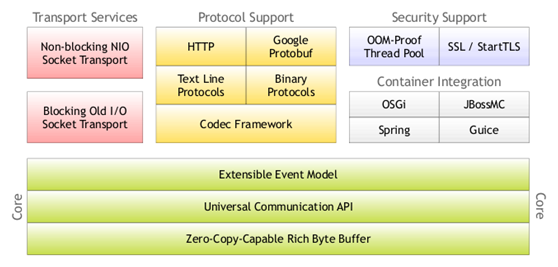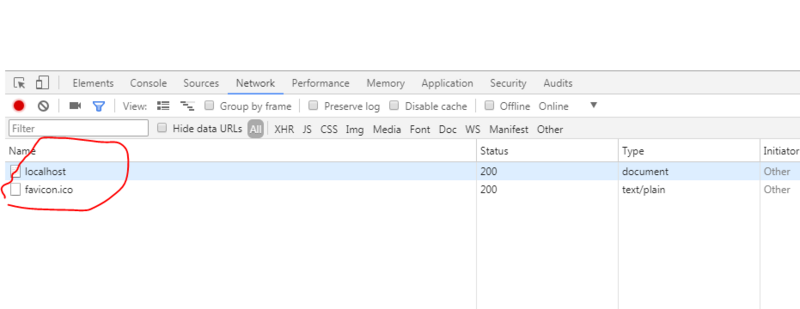netty搭建web聊天室(1)
之前一直在搞前端的东西,都快忘了自己是个java开发。其实还有好多java方面的东西没搞过,突然了解到netty,觉得有必要学一学。
介绍
Netty是由JBOSS提供的一个java开源框架。Netty提供异步的、事件驱动的网络应用程序框架和工具,用以快速开发高性能、高可靠性的网络服务器和客户端程序。
也就是说,Netty 是一个基于NIO的客户、服务器端编程框架,使用Netty 可以确保你快速和简单的开发出一个网络应用,例如实现了某种协议的客户、服务端应用。Netty相当于简化和流线化了网络应用的编程开发过程,例如:基于TCP和UDP的socket服务开发。
一些IO概念
- NIO (non-blocking IO) 非阻塞
- BIO (blocking IO) 阻塞
以上两种又可分为同步和异步,即同步阻塞,同步非阻塞,异步阻塞,异步非阻塞。
- 阻塞:数据没来,啥都不做,直到数据来了,才进行下一步的处理。
- 非阻塞:数据没来,进程就不停的去检测数据,直到数据来。
至于这块的详细概念,大家可以自行百度学习。总之,netty处理io很高效,不需要你担心。
netty结构

可以看出它支持的网络传输协议,以及容器支持,安全支持,io.

工作流程:
所有客户端的连接交给住主线程去管理,响应客户端的消息交给从线程去处理,整个线程池由netty负责。
搭建服务
- 创建maven工程引入最新的依赖
<project xmlns="http://maven.apache.org/POM/4.0.0" xmlns:xsi="http://www.w3.org/2001/XMLSchema-instance"
xsi:schemaLocation="http://maven.apache.org/POM/4.0.0 http://maven.apache.org/xsd/maven-4.0.0.xsd">
<modelVersion>4.0.0</modelVersion>
<groupId>com.mike</groupId>
<artifactId>netty</artifactId>
<version>0.0.1-SNAPSHOT</version>
<properties>
<project.build.sourceEncoding>UTF-8</project.build.sourceEncoding>
<java.version>1.8</java.version>
</properties>
<dependencies>
<dependency>
<groupId>io.netty</groupId>
<artifactId>netty-all</artifactId>
<version>4.1.32.Final</version>
</dependency>
</dependencies>
</project>
- 创建消息处理器
package netty;
import io.netty.buffer.Unpooled;
import io.netty.channel.Channel;
import io.netty.channel.ChannelHandlerContext;
import io.netty.channel.SimpleChannelInboundHandler;
import io.netty.channel.group.ChannelGroup;
import io.netty.channel.group.DefaultChannelGroup;
import io.netty.handler.codec.http.DefaultFullHttpResponse;
import io.netty.handler.codec.http.FullHttpRequest;
import io.netty.handler.codec.http.FullHttpResponse;
import io.netty.handler.codec.http.HttpHeaderValues;
import io.netty.handler.codec.http.HttpHeaders;
import io.netty.handler.codec.http.HttpResponse;
import io.netty.handler.codec.http.HttpResponseStatus;
import io.netty.handler.codec.http.HttpVersion;
import io.netty.handler.codec.http2.Http2Headers;
import io.netty.util.concurrent.GlobalEventExecutor;
/**
*
*/
public class ChatHandler extends SimpleChannelInboundHandler{
public static ChannelGroup channels = new DefaultChannelGroup(GlobalEventExecutor.INSTANCE);
/**
* 每当从服务端收到新的客户端连接时,客户端的 Channel 存入ChannelGroup列表中,并通知列表中的其他客户端 Channel
*/
@Override
public void handlerAdded(ChannelHandlerContext ctx) throws Exception {
Channel incoming = ctx.channel();
for (Channel channel : channels) {
channel.writeAndFlush("[SERVER] - " + incoming.remoteAddress() + " 加入/n");
}
channels.add(ctx.channel());
}
/**
* 每当从服务端收到客户端断开时,客户端的 Channel 移除 ChannelGroup 列表中,并通知列表中的其他客户端 Channel
*/
@Override
public void handlerRemoved(ChannelHandlerContext ctx) throws Exception {
Channel incoming = ctx.channel();
for (Channel channel : channels) {
channel.writeAndFlush("[SERVER] - " + incoming.remoteAddress() + " 离开/n");
}
channels.remove(ctx.channel());
}
/**
* 会话建立时
*/
@Override
public void channelActive(ChannelHandlerContext ctx) throws Exception { // (5)
Channel incoming = ctx.channel();
System.out.println("ChatClient:"+incoming.remoteAddress()+"在线");
}
/**
* 会话结束时
*/
@Override
public void channelInactive(ChannelHandlerContext ctx) throws Exception { // (6)
Channel incoming = ctx.channel();
System.out.println("ChatClient:"+incoming.remoteAddress()+"掉线");
}
/**
* 出现异常
*/
@Override
public void exceptionCaught(ChannelHandlerContext ctx, Throwable cause) { // (7)
Channel incoming = ctx.channel();
System.out.println("ChatClient:"+incoming.remoteAddress()+"异常");
// 当出现异常就关闭连接
cause.printStackTrace();
ctx.close();
}
/**
* 读取客户端发送的消息,并将信息转发给其他客户端的 Channel。
*/
@Override
protected void channelRead0(ChannelHandlerContext ctx, Object request) throws Exception {
FullHttpResponse response = new DefaultFullHttpResponse(
HttpVersion.HTTP_1_1,HttpResponseStatus.OK , Unpooled.wrappedBuffer("Hello netty"
.getBytes()));
response.headers().set("Content-Type", "text/plain");
response.headers().set("Content-Length", response.content().readableBytes());
response.headers().set("connection", HttpHeaderValues.KEEP_ALIVE);
ctx.writeAndFlush(response);
}
}
这里面其实只需要重写channelRead0 方法就可以了,其他是它的生命周期的方法,可以用来做日至记录。我们在读取消息后,往channel里写入了一个http的response。
- 初始化我们的消息处理器
package netty;
import io.netty.channel.ChannelInitializer;
import io.netty.channel.ChannelPipeline;
import io.netty.channel.socket.SocketChannel;
import io.netty.handler.codec.http.HttpRequestDecoder;
import io.netty.handler.codec.http.HttpResponseEncoder;
/**
* 用来增加多个的处理类到 ChannelPipeline 上,包括编码、解码、SimpleChatServerHandler 等。
*/
public class ChatServerInitializer extends ChannelInitializer<SocketChannel>{
@Override
protected void initChannel(SocketChannel ch) throws Exception {
ChannelPipeline pipeline = ch.pipeline();
pipeline.addLast("HttpResponseEncoder",new HttpResponseEncoder());
pipeline.addLast("HttpRequestDecoder",new HttpRequestDecoder());
pipeline.addLast("chathandler", new ChatHandler());
System.out.println("ChatClient:"+ch.remoteAddress() +"连接上");
}
}
这个pipeline可以理解为netty的拦截器,每个消息进来,经过各个拦截器的处理。我们需要响应http消息,所以加入了响应编码以及请求解码,最后加上了我们的自定义处理器。这里面有很多处理器,netty以及帮你定义好的。
- 服务启动类
package netty;
import io.netty.bootstrap.ServerBootstrap;
import io.netty.channel.ChannelFuture;
import io.netty.channel.ChannelOption;
import io.netty.channel.EventLoopGroup;
import io.netty.channel.nio.NioEventLoopGroup;
import io.netty.channel.socket.nio.NioServerSocketChannel;
/**
* The class ChatServer
*/
public class ChatServer {
private int port;
public ChatServer(int port) {
this.port = port;
}
public void run() throws Exception {
EventLoopGroup bossGroup = new NioEventLoopGroup();
EventLoopGroup workerGroup = new NioEventLoopGroup();
try {
ServerBootstrap b = new ServerBootstrap();
b.group(bossGroup, workerGroup)
.channel(NioServerSocketChannel.class)
.childHandler(new ChatServerInitializer())
.option(ChannelOption.SO_BACKLOG, 128)
.childOption(ChannelOption.SO_KEEPALIVE, true);
System.out.println("ChatServer 启动了");
// 绑定端口,开始接收进来的连接
ChannelFuture f = b.bind(port).sync(); // (7)
// 等待服务器 socket 关闭 。
// 在这个例子中,这不会发生,但你可以优雅地关闭你的服务器。
f.channel().closeFuture().sync();
} finally {
workerGroup.shutdownGracefully();
bossGroup.shutdownGracefully();
System.out.println("ChatServer 关闭了");
}
}
public static void main(String[] args) throws Exception {
new ChatServer(8090).run();
}
}
这个启动类就是按照上面那个结构图来的,添加两个线程组,设置channel,添加消息处理器,配置一些选项option。
- 测试
启动程序,浏览器访问 http://localhost :8090


可以在浏览器看到我们返回的消息,但是控制台却显示连接了多个客户端,其实是因为浏览器发送了无关的请求道服务端,由于我们没有做路由,所以所有请求都是200。

可以看到,发送了两次请求。现在我们换postman测试。

这次只有一个客户端连接,当我们关闭postman:

客户端显示掉线,整个会话过程结束。
总结
我们完成了服务端的简单搭建,模拟了聊天会话场景。后面再接着完善。
别忘了关注我 mike啥都想搞

还有其他后端技术分享在我的公众号。
- 本文标签: 数据 XML 同步 生命 服务端 协议 https UI App 开源 http IO 服务器 ip 配置 UDP 百度 DDL NIO web pom 安全 TCP 总结 src executor apache maven cat Netty final client 处理器 java db 进程 管理 开发 build 线程池 remote Bootstrap dependencies schema IOS BIO 端口 线程 IDE value Connection ACE id 测试
- 版权声明: 本文为互联网转载文章,出处已在文章中说明(部分除外)。如果侵权,请联系本站长删除,谢谢。
- 本文海报: 生成海报一 生成海报二











![[HBLOG]公众号](https://www.liuhaihua.cn/img/qrcode_gzh.jpg)

